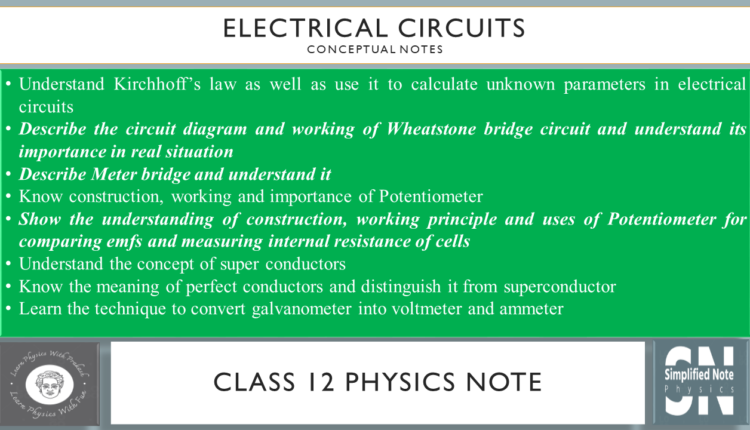Chapter: Electrical circuits
-
-
Understand Kirchhoff’s law as well as use it to calculate unknown parameters in electrical circuits.
-
Describe the circuit diagram and working of Wheatstone bridge circuit and understand its importance in real situation.
-
Describe Meter bridge and understand it
-
Know construction, working and importance of Potentiometer
-
Show the understanding of construction, working principle and uses of Potentiometer for comparing emfs and measuring internal resistance of cells
-
Understand the concept of super conductors. Know the meaning of perfect conductors and distinguish it from superconductor
-
Learn the technique to convert galvanometer into voltmeter and ammeter
-
Kirchhoff’s’ law:
Kirchhoff’s current law: [KCL] [point law; node law; junction law]
Statement: The algebraic sum of current meeting at a point (junction) is always zero.
This law is based on the principle of conservation of charge.
For a point in an electrical circuit,
- Entering current is taken positive.
- Leaving current is taken negative.
![]()
In the given figure,
The Kirchhoff’s current law can be written as:
Restatement: sum of entering current = sum of outgoing current
Note: The charges cannot accumulate at a junction. The number of charges that arrive at a junction in a given time must leave in the same time in accordance with conservation of charges.
Kirchhoff’s voltage law: [KVL] [loop law; mesh law]
Statement: The algebraic sum of the potential differences in any loop, including those associated with emfs and those of resistive elements, must equal zero. That is,
This law is based on the principle of conservation of energy.
Sign convention: In a closed loop in an electrical circuit,
- Gain in potential is positive.
- Loss in potential is negative.
![]()
In the given figure,
The Kirchhoff’s voltage law in closed loop ADCBA:




sir potentiometer ko question ni rakhdinu na